I have an old quilt stitched by my maternal grandmother. My mother used to keep it folded atop her cedar chest in the basement; now it makes the rounds from bedroom to bedroom in my own house, depending on who last snagged it.
My grandmother wasn’t a skilled seamstress—the quilt is a motley mix of fabric remnants haphazardly stitched together. It’s also well-used, to the point of disrepair. Many of the patches are threadbare, and those originally made of satin have worn away altogether, revealing the dingy cotton batting. Despite its ragtag appearance, there is still something appealing about that quilt: the weight of it on me as I lay beneath it, the explosion of colors and patterns, loud and raucous like a carnival. I like to imagine my grandmother stitching it, a cigarette smoldering in the ashtray at her side, a pile of scraps at her feet.
Though I don’t quilt (I don’t sew at all—not even errant buttons or unraveled hems), I’m drawn to quilts like a bee to phlox. I recently visited The International Quilt Study Center & Museum, a 37, 000-square-foot brick and glass building on the University of Nebraska-Lincoln East Campus. I worked in an office across the street from the museum for ten years, yet despite my best intentions, I never ventured inside the museum, which houses more than 4, 200 quilts from around the world.
As I climbed the broad, curving staircase into the open, sunlit space on the second floor, I expected to be greeted by a cacophony of color. Turns out, the quilts are not displayed in that bright space. Over time light deteriorates the delicate fabrics, so the quilts are displayed in windowless rooms with special non-florescent dim lighting. The galleries exhibit just 40-60 quilts at one time – most of the museum’s quilts are packed in acid-free archival boxes and stored in temperature- and humidity-regulated rooms.
Of the three exhibits on display when I visited, I was especially intrigued by “Signature Cloths, ” a show highlighting quilts decorated with distinctive hand-written and embroidered autographs.
“Though unified in name, the signature cloths represent unique stories, each told through the process of signing and stitching, ” visiting curator Lynn Setterington explains in the exhibit brochure. “Some are solemn, some are whimsical, but all are earnest representations of a meaningful, social experience the signers shared.
For example, dozens of signatures from refugees of Iran, China, Egypt, Czech Republic and other countries across the globe decorate the colorful blocks of the Rainbow Haven Signature Cloth a quilt, made in 2011 by Setterington and members of the Rainbow Haven refugee community in Manchester, England.
On the far wall, 450 scarlet signatures arranged like spokes of a dozen wheels decorate a quilt made to raise funds for the Maple Grove Ladies Aid Society in 1920. Fundraising quilts such as this one were popular in the late nineteenth and early twentieth centuries, with donors often contributing a few cents or a dime to the cause to have their name included.
On the far side of the gallery a large white quilt festooned with signatures, pictures and symbols illustrates the everyday life of Rose Schinnerling, who lived in Peoria, Illinois, in the 1940s. Rose’s friends, family and neighbors signed the quilt, as did a number of people from her daily life, including her doctor, beautician, dressmaker and a woman named Katie, who perhaps saw a potential advertising opportunity in the quilt and signed herself as Rose’s “favorite clerk.”
“Signatures are personal and physical inscriptions, ” says Ramallah-based visual artist and writer Shuruq HarB, “symbolic and romantic gestures, but also visual signs that are still used today as ‘information’ or ‘evidence’ for the verification of someone’s identity.”
Rose Schinnerling’s quilt, it seems, speaks to that identity – not only the unique identity of Rose herself, but also how her identity was shaped and defined, at least in part, by the members of her community.
As I gazed at the hundreds of signatures penned onto and embroidered into the fabrics displayed around the gallery, I mused over who I might ask to sign my autograph quilt, were I quilter. My husband and my two children for sure; my neighbors, Karna and John; a handful of friends here in town. Certainly not my doctor or my hair stylist, and I don’t have a dressmaker or a “favorite clerk.” Likewise, the members of my extended family – my parents, my sister, my aunts, uncles and cousins – live 1, 500 miles away, a distance not exactly conducive to drop-by visits for quilt-signing.
Standing in the middle of the gallery, surrounded by signatures from both the past and present, I started to realize that, given the predominance of online connection in my life and my relative lack of in-person community, my own “signature cloth” might look very sparse indeed.
Featured image by Mary-Frances Main, Creative Commons license via Flickr. Post and photos by Michelle DeRusha.
___________________
Curl up under your favorite quilt with a cup of tea and a poem.
Subscribe to Every Day Poems and find some beauty in your inbox.
- Regional Tour: Homestead National Monument, Beatrice, Nebraska - November 13, 2015
- Making Little Free Library No. 25, 001 - November 4, 2015
- Regional Tour: North House Folk School, Grand Marais, Minnesota - August 12, 2015
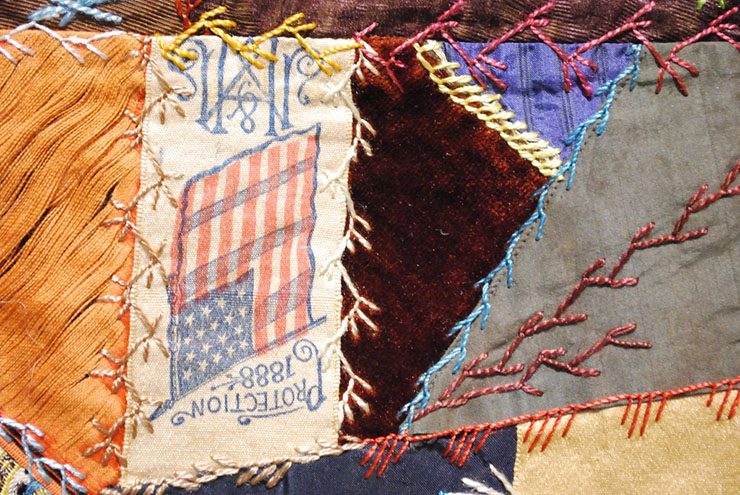
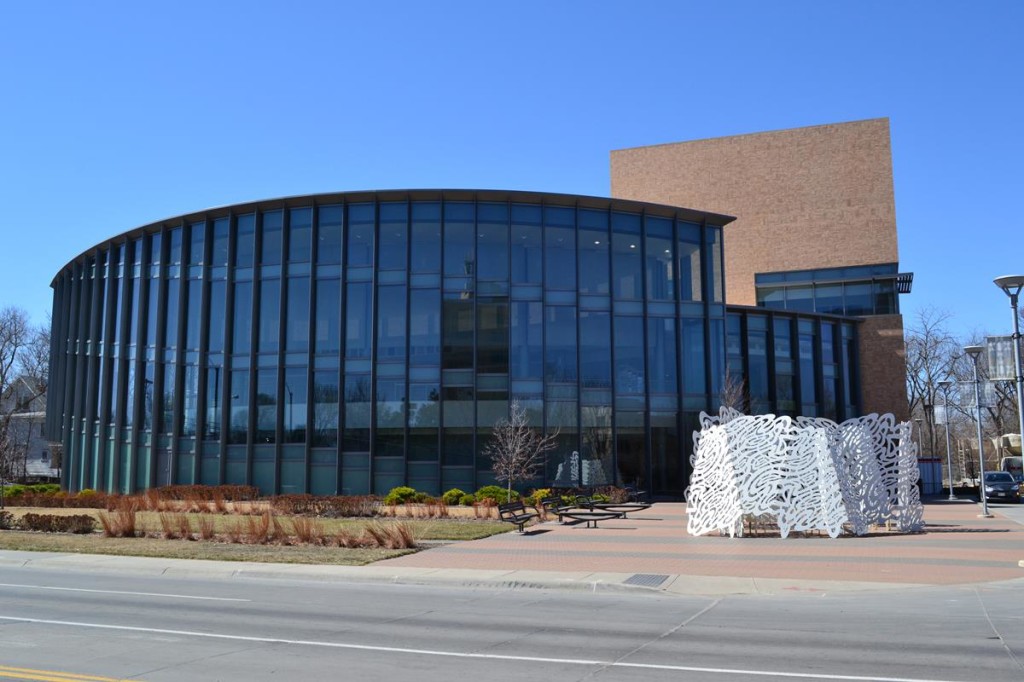
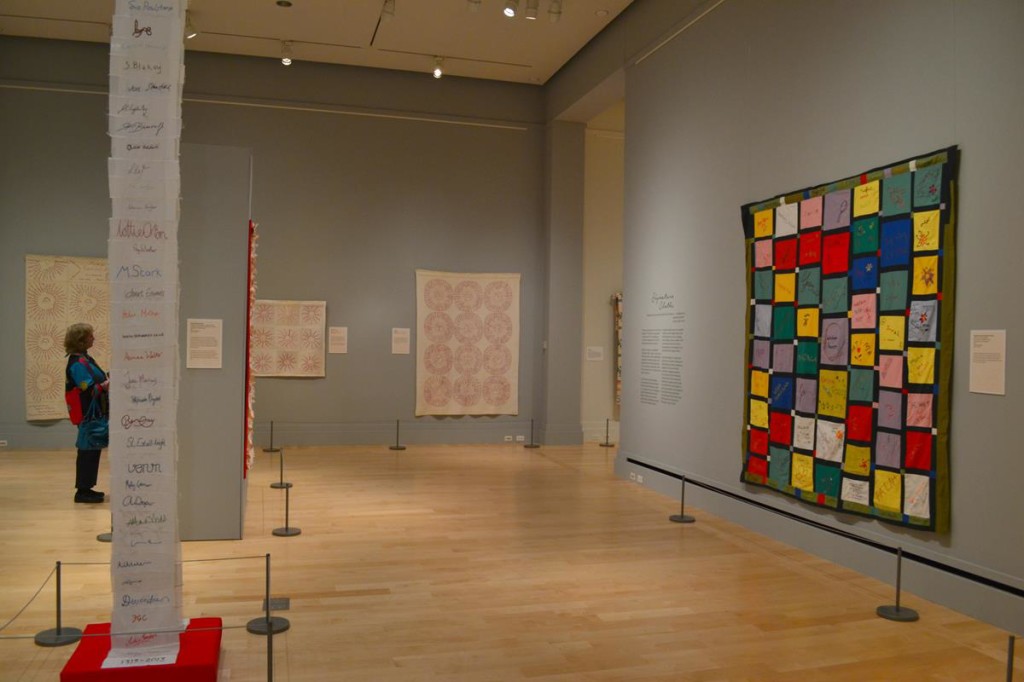
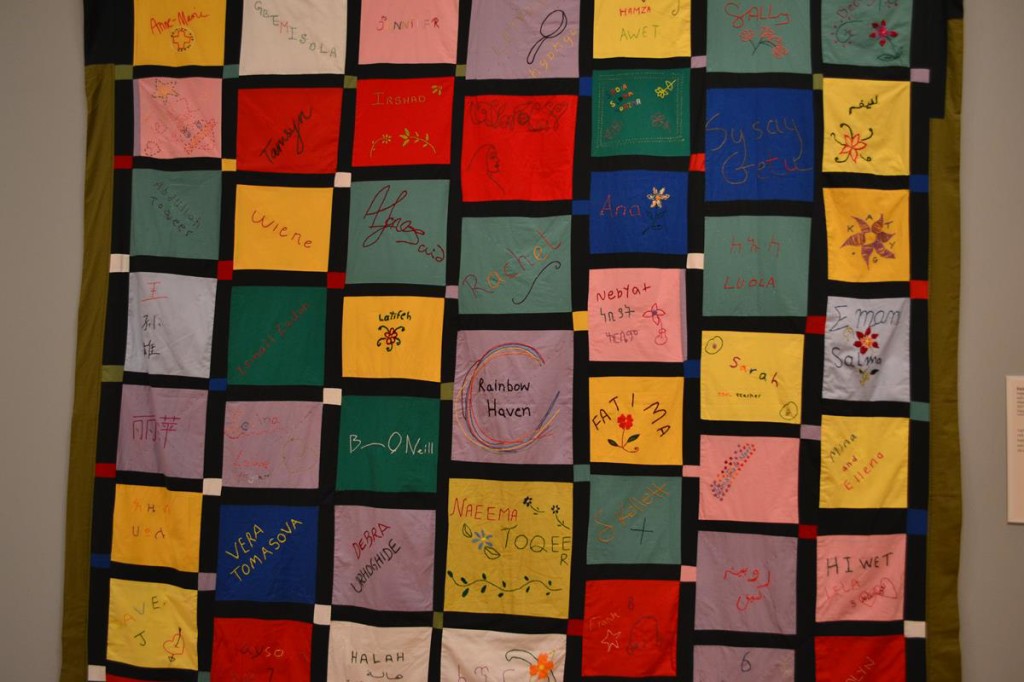
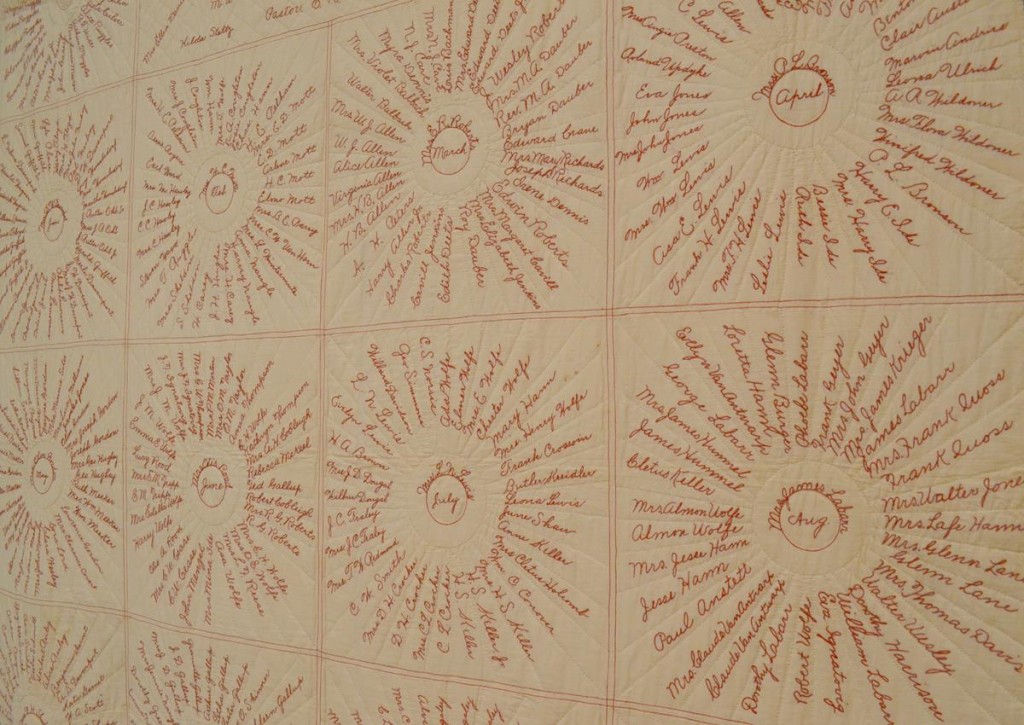
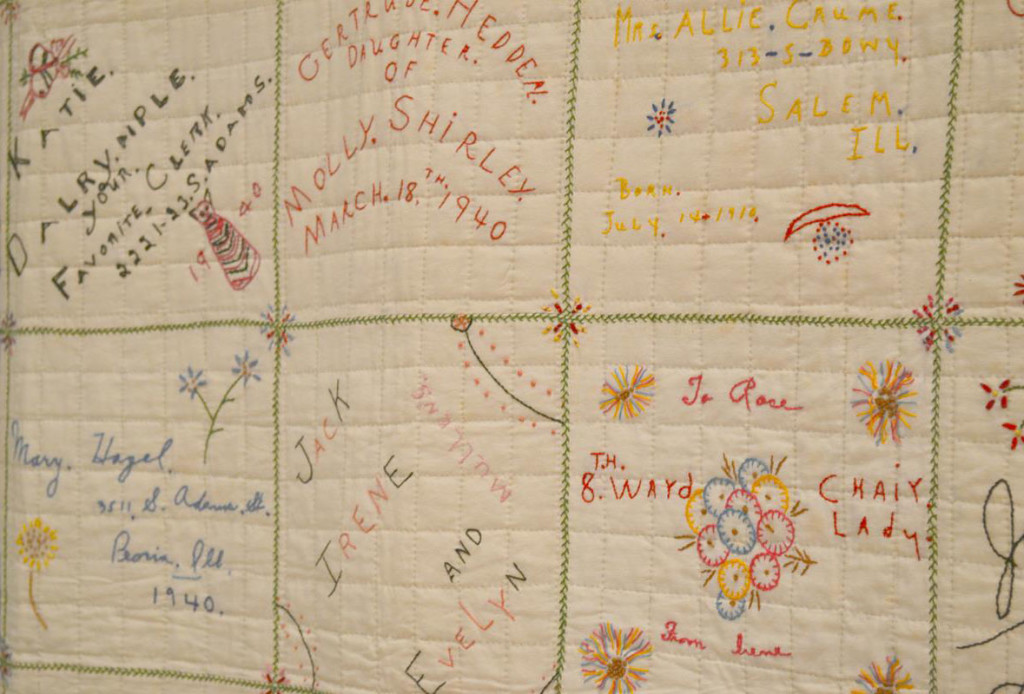
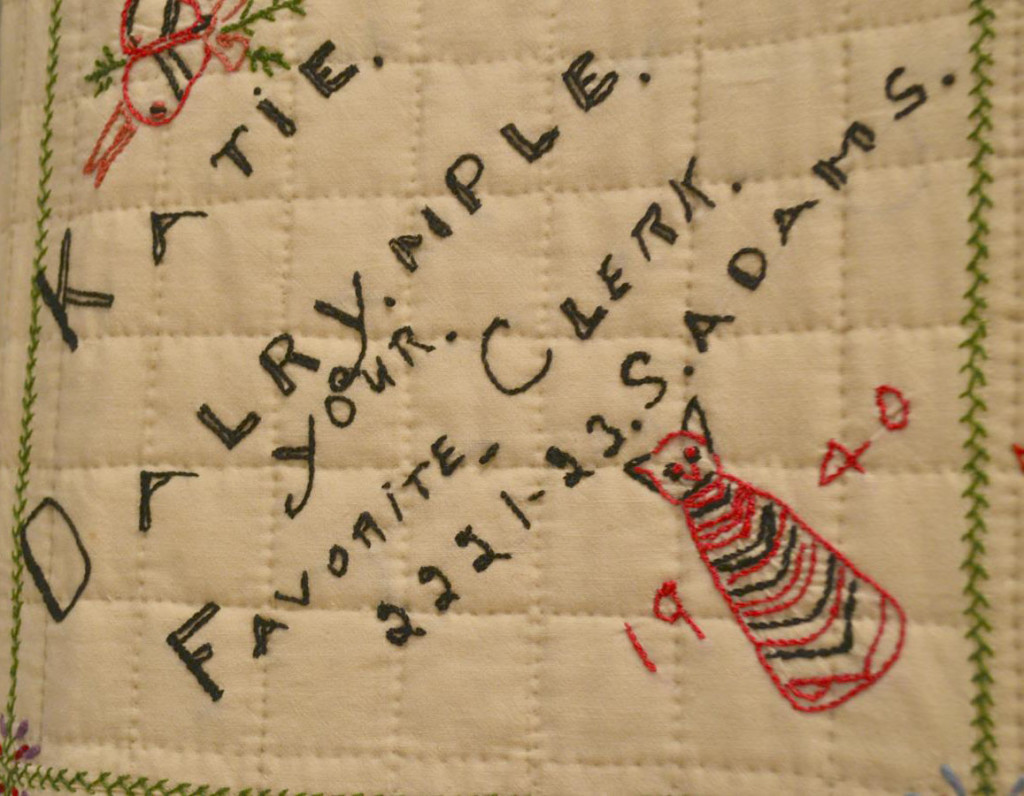

LLB says
A year or two ago, the Arkansas Art Center yarn-bombed the front of the building in a collaborative project. People sent knitted and crocheted stuff from all over the country.
I think you could gather many signatures from outside Nebraska just by asking.
What a neat exhibit. I’m glad that’s the one that was there when you walked in the door.
Diana Trautwein says
I love quilt exhibits! I just gave away about 3 of mine to my daughters and daughter-in-law just a couple of weeks ago. They were old and well-worn, but still lovely — all of the ‘family heirlooms.’ And I still have several left. 🙂 Including one that has never been backed and finish-quilted. It consists of about 30 squares from family and friends who surprised us at a 25th anniversary party thrown by our kids almost 25 years ago! My eldest daughter organized the quilting part and sent squares to each person invited and then stitched them all together into the top. She was heavily pregnant with child #1 and never finished it off. Now she just might. Wouldn’t that be fun?
Katie says
My two sister-in-laws quilt and had all their siblings and their children put a block quilt together in 1998 for their parent’s 50th anniversary. It was a treasure then and even more so this past November to see it again at their father’s funeral beautifully displayed atop the piano at the cathedral and later at the luncheon reception. It was an opportunity for much fond reminiscence and sharing of stories among family and friends:) What a blessing!